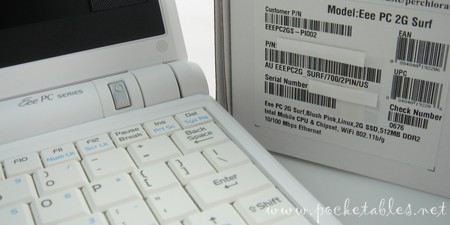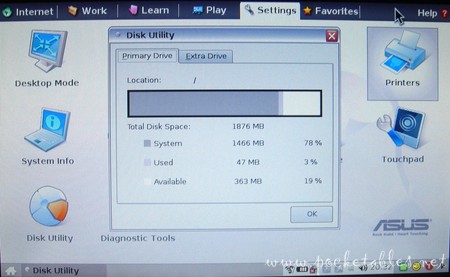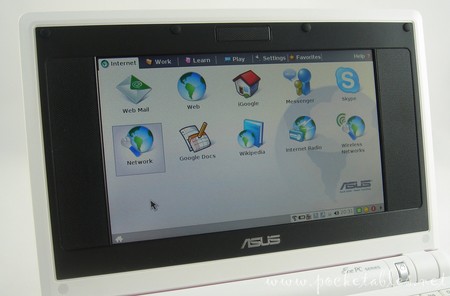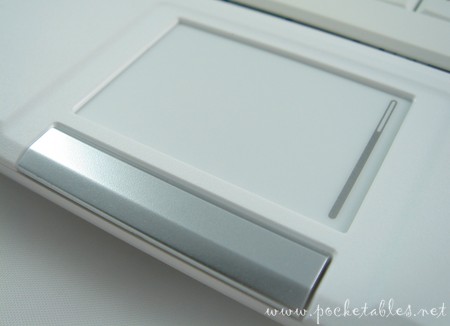10 reasons not to buy the Asus Eee PC 2G Surf
The entry-level Asus Eee PC is the 2G Surf, a $299 mini notebook that many assume differs from its more expensive siblings in little more than storage capacity.

A quick look at the official specs chart appears to confirm that the 2G Surf is identical to its brethren in every way except that the 4G Surf has a 4GB flash drive; the 4G has a 4GB flash drive, webcam, and longer battery life; and the 8G has all of that plus a bigger SSD (8GB) and more RAM (1GB). Great! Buying the 2G Surf will save those who don’t need the extra storage $50 and those who also don’t need the webcam and extra runtime $100 with no additional sacrifice.
That’s what the official product page would lead consumers to believe, anyway. The truth is that the Eee PC 2G Surf is so compromised that at its current price, it’s not worth buying at all.
Before I explain why the 2G Surf should be avoided, here’s a screen capture (click to enlarge) of the published specs:
Although some may argue that it’s the buyer’s responsibility to fully research a product before purchasing it, mainstream consumers shouldn’t be faulted for trusting a comparison chart listed on a company website.

Side note: I knew the chart glossed over key differences between the systems when I got my 2G Surf last week, but I didn’t care. As mentioned in my unboxing, I chose this model because it was the only one available in pink at the time (pink 4G has since been released).
Reason 1: Performance
Unlike the other three models in the Eee PC series, which house 900MHz Intel Celeron M processors underclocked to 633MHz, the 2G Surf has an 800MHz CPU underclocked to run at 571MHz. And whereas its beefier siblings have L2 caches of 512KB, it has only an L1 cache of 32KB. Not surprisingly, then, the 2G Surf’s performance suffers. And coming from someone like me, who has no technical expertise and is not a power user of anything, that says a lot.
The 2G Surf is sometimes so slow to respond to simple commands that I often think the system has crashed. Sometimes I end up with multiple Firefox sessions open because I’ve clicked on the Web icon several times, assuming my taps weren’t being registered. A lag is noticeable even when doing light tasks like changing a setting or increasing the volume.
Reason 2: Available storage
The SD card slot makes this somewhat of a non-issue, but it’s worth noting that of the stated 2GB flash drive soldered into the 2G Surf, only about 360MB is free out of the box.

Granted, those who buy this model already knowingly commit to having the least amount of storage in the Eee PC lineup available to them. But considering that the 4G Surf and 4G models have 1.4GB of their 4GB SSDs free, new 2G Surf owners may expect 700MB free on a 2GB drive.
Reason 3: Fewer applications
In addition to having less available space than expected, the 2G Surf also has fewer applications than its siblings.

Missing from the device are the following:
- eBook and World Clock (Internet tab)
- Mail and Notes (Work tab)
- Science (Learn tab)
- Sound Recorder, Webcam, Sudoku, Crack Attack, and LTris (Play tab)
- Voice Command (Settings tab)
Reason 4: Soldered RAM
While owners of the Eee PC 4G, 4G Surf, and 8G crack open their mini notebooks to upgrade the socketed RAM (up to 2GB supported) and improve performance, 2G Surf users are stuck with the preinstalled 512MB module, which is soldered to the motherboard.
Reason 5: Battery life
Both the 2G Surf and 4G Surf models ship with a 4400mAh li-ion battery with a runtime estimate of 2.8 hours. This is clearly stated in the official specs (so buyers know beforehand what they’re getting), but it still deserves a spot on this list because 2.8 hours isn’t good. Battery life is closer to 2 to 2.5 hours in real-world use, which was the widely criticized number achieved by all first-generation UMPCs. Yes, UMPCs were several times more expensive than even the high-end Eee PC, but 2.5 hours on a mobile device is still just 2.5 hours on a mobile device.
The 4G and 8G have higher-capacity batteries capable of about 3.5 hours of operation.
Reason 6: Space bar
I assume this is true of the other models as well, but since I only have the 2G Surf in my hands, I’ll just say that on my unit, the space bar on the keyboard is terrible.

Nearly an inch (half-inch on each side) of the three-inch space bar is completely unresponsive. Though not impossible to work around, making a conscious effort to press only the middle of the space bar negatively affects initial typing speed. And what’s the point of the key being three inches long if only two inches actually do anything?
Reason 7: Touchpad responsiveness
The touchpad sensitivity can be customized, but I still find its tapping responsiveness and consistency questionable (even when "Enable faster tapping" is checked and "Tapping time" is set to "Short" in the touchpad settings menu). This may just be a performance issue, but sometimes a forceful double-tap is required where a light single-tap has previously sufficed. Constantly having to re-tap particularly impedes enjoyable use of the 2G Surf when browsing the web.
Those who use the touchpad solely for navigation and scrolling should encounter no problems.
Reason 8: Mouse buttons
Housed beneath the single strip of silver plastic below the touchpad are the left and right mouse buttons.

They work as they should, but they’re harder to press and louder than any other set of buttons I’ve ever encountered on a full-size or mini notebook. The 2G Surf’s buttons (and presumably those of the other models as well) require a very deliberate, definitive click; unlike on standard laptops or devices with similar buttons, they don’t register from light taps.
Reason 9: Boot time
Asus never claimed that the Eee PC was an instant-on device (it’s not), but the unit’s quick boot-up has been trumpeted as one of its achievements. The 2G Surf does turn on much faster than a traditional Windows XP system, but it’s not that fast. Not including the time it takes to connect to a network and actually launch Firefox, my factory-fresh 2G Surf takes 9 seconds to awaken from standby and about 34 seconds to cold boot.

In comparison (and yes, I know this is unfair), my unoptimized Vaio TZ running Vista Business takes just 8 seconds to awaken from standby, connect to my home network, and launch Firefox. My own cold boot is atrocious, but a Pocketables reader is cold booting his heavily tweaked TZ in 38 seconds.
Again, I know that comparing the $300 2G Surf to a $2500+ Vaio TZ is absurd. But since many people cite fast boot times as a compelling reason to purchase the 2G Surf over a more capable (and yes, more expensive) device, I wanted to illustrate that while they are good, the 2G Surf’s boot times don’t necessarily live up to the hype (and not just when compared to the TZ).
Reason 10: Price
For a fully functioning ultraportable computer capable of running Windows XP and a host of other standard applications, the Eee PC 2G Surf’s asking price of $299 sounds incredibly reasonable, especially when compared to other similarly sized UMPCs and handtops. However, when taking everything listed above into account and considering the cost of the higher Eee PC models, it’s actually overpriced.
Based on the specs chart, the $50 separation between the 2G Surf and the 4G Surf seems like a fine deal because the only difference appears to be a 2GB and 4GB flash drive. Uninformed consumers are unaware that an extra $50 would get them not just more storage capacity, but better performance by way of a faster processor, upgradeable RAM, and more preinstalled applications. An extra $100 would get them all of that plus a webcam and better battery life.

For what it is, then, the 2G Surf should’ve been priced at around $199. That’s how much it was supposed to have been in the first place.
If you want an Asus Eee PC, buy the 4G Surf ($349), 4G ($399)
, or 8G ($499) models instead.
Update 2.24.08: Returning the Asus Eee PC 2G Surf


